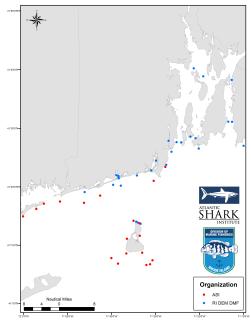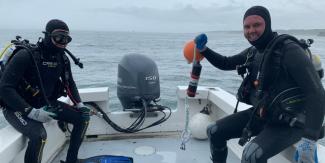Acoustic Receivers
Acoustic tags are often used to understand marine species’ migration routes and habitat use. In 2019, an acoustic telemetry array was constructed to understand marine species residing or transiting Rhode Island state waters. Detections of species that have been acoustically tagged and enter the array provide quantifiable data regarding their spatial-temporal distribution. These detections have a broad suite of applications for Rhode Island, including understanding the timing of arrival and departure for seasonal species, identifying areas of critical habitat or importance for taxa, and capturing the presence of species that are not well detected in traditional fisheries-independent survey gear. Such data is often used in stock assessments, quota management, and public safety practices.
The acoustic array in Rhode Island consists of several stations with a buoy, line and anchor equipped with a receiver that ‘listens’ for tagged fish. The tagged fish are those that have been tagged as part of projects all along the coast by researchers across several species for a plethora of different scientific studies. There are currently 12 stations with acoustic receivers in Rhode Island state waters collaboratively maintained: nine are managed by RIDEM DMF, and three are managed by the Atlantic Shark Institute (ASI). This collaboration allows for the array to expand for a better coverage of the state’s waters.
The array is deployed seasonally. Receivers are usually in the water between April and early May and retrieved in the late fall.
With the acoustic array established, both DMF and ASI will being tagging projects for certain species to better understand their movement and habits within Rhode Island and local southern New England waters.

Rhode Island Division of Marine Fisheries (RIDMF). 2021. Rhode Island Acoustic Receiver Array: 2020 Summary Report. Jamestown, RI.
For more information about the survey please contact Chris Parkins


